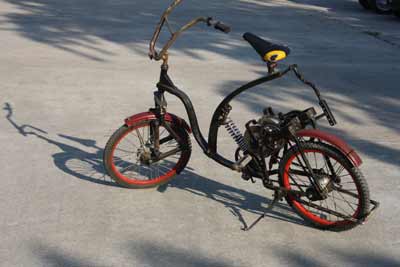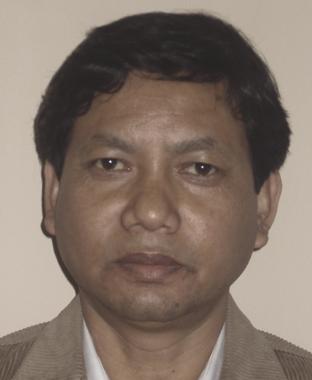Serial Innovator Hover craft, amphibious craft, rumble strip for generation of electricity, car run with compressed engine , gravitational bicycle and others
Genesis of innovation
The first innovation Kanak made was an air gun, almost soundless, when he was a student of class six. He won first prize when he displayed it in an exhibition. But the gun was thereafter taken away from him for safety. It was only after he settled down to be a general order supplier to various parties and government departments that he could focus on his childhood dream of building cars, planes and boats.
Gravity operated cycle: He has built an arrangement in the bicycle to harness the repeated downward movement of the rider on a spring-loaded seat. This would charge a spring that would release the energy and make the cycle move without much pedaling. The rider on the cycle appears like galloping on a horse as he sits on a reciprocating seat fitted to the fulcrum lever. Due to the eccentricity of the rear wheel and the spring loaded lever arm, the person on the rider’s seat gets lifted up with changes in the levels of potential energy and spring recoil. Against this, gravitational force again pulls the rider down. Prior art does not disclose any comparable model where the principle of gravity, rider’s weight and conservation of energy have been combined. Kanak Das did use similar motion in his rider induced bicycle for which he was awarded earlier by NIF.
TRYGO X, a three wheeler: He developed it to fulfill the wishes of his seven year old daughter. As she was tired of traffic jams in the city, she asked him to develop a small vehicle that could smartly zip in and weave through the city traffic. The TRYGO X could weave in a lane with a span of 6 feet, and sharply turn and park perpendicular to the curb. It can travel at 60 km/hr and has an average mileage of 30 km/liter.
Kanso hybrid car: This is a new concept hybrid car without gears that runs on solar power as well as on fuel. The car has a 100-cc engine powered by four solar panels generating 320 Watts of energy. The engine of the car is basically powered by battery power. The battery charger is hybrid, during daytime the battery can be charged by solar power and at night or in emergencies the battery can be charged by the fuel.
Retrofitted rickshaw: This is a rickshaw fitted with a differential to enable each driving wheel to rotate at different speeds, while supplying equal torque. The low rolling resistance and lightweight made the vehicle energy efficient and comfortable to drive and handle.
Compressed air car: This is a car with a unique arrangement; integration of motorcycles and Maruti car engines, run with compressed air. Kanak claims to get a maximum speed of 120 km/h in this car.
Some of the other innovations that Kanak has come up with are Powered hang glider using a 2-stroke motorbike engine in 2001; Aeroboat (Shallow bottom boat propelled with on board aero-propeller) in 2002; Amphibian boat using on board aero-propeller in 2003; Water bicycle; Treadmill bike; and “Kontilo” 5.5 hp Mini Tractor for ploughing, tilling and rural transportation both for hilly and plain terrain
Product application and dispersion
After a lifetime of effort and struggle, Kanak’s innovative spirit seems to be finally getting recognition at the national and global platforms. He received the Vocational excellence Award for the year 2007-2008 from Rotary International, Durgapur. He also attended the International seminar on Renewable Energy at New Delhi and Husum, Germany in 2008. NIF facilitated participation of the innovator in a Fab Lab conference organized by the Massachusetts Institute of Technology at Chicago, USA in 2007. The innovator has also received enquiries from countries like the United States for exploring possible technology transfers for his technologies.
Kanak Gogoi, since childhood, always had a dream and hobby to do things unique and different and innovate things for the betterment of humanity in a cost effective way. He started developing in 1996 after setting up a small garage at his home in Mathura Nagar, Guwahati. . From a businessman and product designer, Kanak has evolved into a serial innovator. Over the years, he has primarily developed transportation solutions encompassing air, land and water.
Background
Kanak (47) hails from Tekelbora village in North Lakimpur District of Assam. His father, Buduram Gogoi, worked as a clerk in the land reform department. Kanak completed his primary education and high school at Laluk. After his High School he went to Jorhat and joined the pre-university course. Dropping out of the course, he decided to stay back at Jorhat. To earn a living, he started collecting milk from villages around Jorhat and selling it in the city.
He continued the milk business for three years. He supplemented this income by doing other odd jobs. While working at various mechanical workshops in Jorhat, his thirst for technical knowledge increased. He spent his waking hours in experimentation and reading technical publications. In spite of being financially insecure, he had found a new confidence in his abilities. He started his own signboard workshop in rented premises. In the year 1986, Kanak’s hard work paid off and his signboard business earned good revenues. He diversified into the transportation business after investing in a taxi and matador. Unlike job work, this business experienced wild swings and needed social networking. Kanak could neither manage nor compete in this business and ended up in the red.
The news of his bankruptcy filtered back to his village. His parents got worried and asked him to come home for the second time. Kanak refused, as he was confident that he would live to fight another day. He sold all his belongings and shifted with one taxi to Guwahati. He was back to square one and now had to start things right from the scratch. After getting knocked about for some time, he settled down to be a general order supplier to various parties and government departments.
In 1996, Kanak married Manju, his good friend’s sister. His friend was a doctor who admired his zeal for innovations. His passionate zeal for innovations and unconventional non-commercial lifestyle created problems with his wife. It finally led to separation. Currently Kanak lives with his second wife at Guwahati and his four children from two marriages.
1288/KOL/2009








